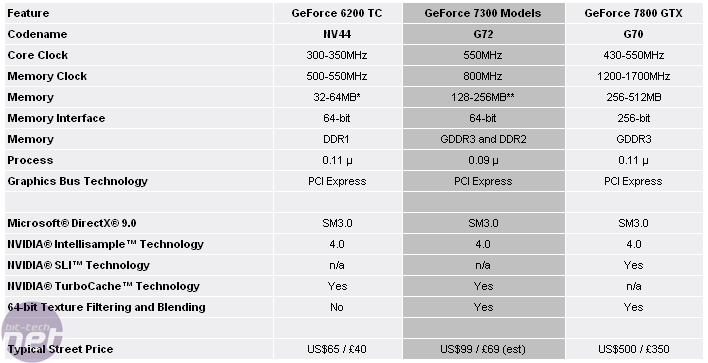Features
The GeForce 7300 GS core has four pixel pipes, three vertex shaders and two pixel output engines/rasterisers. The core clock is 550MHz - up from the 300 / 350MHz that the 6200 TC was clocked at. The latter's DDR1 memory goes in the bin in favour of the faster DDR2, which is clocked at 800MHz DDR though the 64-bit memory interface will still handicap performance somewhat.Initially, you will be able to buy the 7300 GS with either 128MB or 256MB of on-board DDR2 memory - a far cry the 6200 TurboCache's 32MB / 64MB initial configurations. Much like the GeForce 6200, the GeForce 7300 GS utlilises TurboCache technology, and will use a certain amount of system RAM to offer a larger frame buffer.
For example, in a 512MB system, the 128MB card will use 128MB of system memory to give a virtual 256MB frame buffer. If your system has 1GB of memory, the 256MB 7300 GS will use another 256MB to seamlessly present games with a 512MB frame buffer. This is the maximum possible - having 2GB of RAM will make no difference to the graphics card.
There was, of course, the standard GeForce 6200 too, which was based on NV43 with one quad of pixel shader units disabled. Those cards ended up using 256MB of memory, with some partners shipping cards with a crazy 512MB onboard. This was clearly a marketing ploy, because you're not going to require 512MB of dedicated texture memory for gaming any time soon, and certainly not in the timeframe that the GeForce 6200 GPU would still be able to compute more than fives frames per second.

The pixel shader also features the same improvements that were found in GeForce 7800 GTX. NVIDIA spent a great deal of time optimising and improving the throughput in each pixel pipeline. This means that they're able to do more work every clock cycle with the same number of pixel pipelines.
Where the high-end is concerned, there are limitations on die size, so it's not always easy to implement more pipelines because each pixel pipeline can cost millions of transistors. At the low-end, the main limitation is packing as much performance as possible into the smallest space - this is ultimately a transistor limitation too.
To combat this, NVIDIA introduced some shader-based optimisations in the Pixel Shader, meaning that popular Shader instructions are processed much faster than was possible with GeForce 6200 TurboCache. Typically, the most popular Shader command is Multiply-Add (MAD) - this is recognised by the Pixel Shader and is processed much more efficiently than before - it'll take a single clock cycle to complete the instruction, rather than two or three as was the case with previous GPUs.
The 7300 will support high-definition video decoding with the upcoming 85-series driver, released in March (we suspect). This will enable not just the standard PureVideo features, but also H.264 video decoding in hardware - making for silky-smooth 1080p playback of high definition content.

MSI MPG Velox 100R Chassis Review
October 14 2021 | 15:04






Want to comment? Please log in.